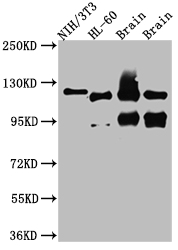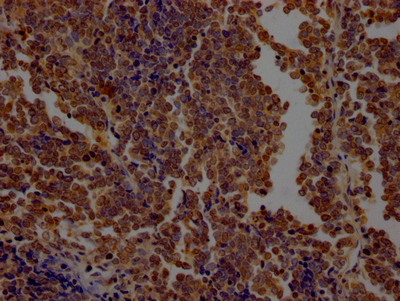
Western Blot Positive WB detected in: NIH/3T3 whole cell lysate, HL-60 whole cell lysate, Rat Brain whole cell lysate, Mouse Brain whole cell lysate All lanes: OGT antibody at 1:1000 Secondary Goat polyclonal to rabbit IgG at 1/50000 dilution Predicted band size: 117, 104, 116, 75 kDa Observed band size: 117 kDa
OGT Recombinant Monoclonal Antibody
CSB-RA232619A0HU
ApplicationsWestern Blot, ELISA, ImmunoHistoChemistry
Product group Antibodies
ReactivityHuman, Mouse, Rat
TargetOGT
Overview
- SupplierCusabio
- Product NameOGT Recombinant Monoclonal Antibody
- Delivery Days Customer20
- ApplicationsWestern Blot, ELISA, ImmunoHistoChemistry
- CertificationResearch Use Only
- ClonalityMonoclonal
- Clone ID8G7
- ConjugateUnconjugated
- Gene ID8473
- Target nameOGT
- Target descriptionO-linked N-acetylglucosamine (GlcNAc) transferase
- Target synonymsHINCUT-1; HRNT1; MRX106; O-GLCNAC; O-GlcNAc transferase p110 subunit; O-GlcNAc transferase subunit p110; OGT1; O-linked N-acetylglucosamine (GlcNAc) transferase (UDP-N-acetylglucosamine:polypeptide-N-acetylglucosaminyl transferase); O-linked N-acetylglucosamine transferase 110 kDa subunit; UDP-N-acetylglucosamine:polypeptide-N-acetylglucosaminyl transferase; UDP-N-acetylglucosamine--peptide N-acetylglucosaminyltransferase 110 kDa subunit; uridinediphospho-N-acetylglucosamine:polypeptide beta-N-acetylglucosaminyl transferase; XLID106
- IsotypeIgG
- Protein IDO15294
- Protein NameUDP-N-acetylglucosamine--peptide N-acetylglucosaminyltransferase 110 kDa subunit
- Scientific DescriptionCatalyzes the transfer of a single N-acetylglucosamine from UDP-GlcNAc to a serine or threonine residue in cytoplasmic and nuclear proteins resulting in their modification with a beta-linked N-acetylglucosamine (O-GlcNAc). Glycosylates a large and diverse number of proteins including histone H2B, AKT1, EZH2, PFKL, KMT2E/MLL5, MAPT/TAU and HCFC1. Can regulate their cellular processes via cross-talk between glycosylation and phosphorylation or by affecting proteolytic processing. Involved in insulin resistance in muscle and adipocyte cells via glycosylating insulin signaling components and inhibiting the Thr-308 phosphorylation of AKT1, enhancing IRS1 phosphorylation and attenuating insulin signaling. Involved in glycolysis regulation by mediating glycosylation of 6-phosphofructokinase PFKL, inhibiting its activity (PubMed:22923583). Component of a THAP1/THAP3-HCFC1-OGT complex that is required for the regulation of the transcriptional activity of RRM1. Plays a key role in chromatin structure by mediating O-GlcNAcylation of Ser-112 of histone H2B: recruited to CpG-rich transcription start sites of active genes via its interaction with TET proteins (TET1, TET2 or TET3) (PubMed:22121020, PubMed:23353889). As part of the NSL complex indirectly involved in acetylation of nucleosomal histone H4 on several lysine residues (PubMed:20018852). O-GlcNAcylation of Ser-75 of EZH2 increases its stability, and facilitating the formation of H3K27me3 by the PRC2/EED-EZH2 complex (PubMed:24474760). Regulates circadian oscillation of the clock genes and glucose homeostasis in the liver. Stabilizes clock proteins ARNTL/BMAL1 and CLOCK through O-glycosylation, which prevents their ubiquitination and subsequent degradation. Promotes the CLOCK-ARNTL/BMAL1-mediated transcription of genes in the negative loop of the circadian clock such as PER1/2 and CRY1/2 (PubMed:12150998, PubMed:18288188, PubMed:19377461, PubMed:19451179, PubMed:20018868, PubMed:20200153, PubMed:21285374, PubMed:15361863).
- ReactivityHuman, Mouse, Rat
- Storage Instruction-20°C or -80°C
- UNSPSC12352203

